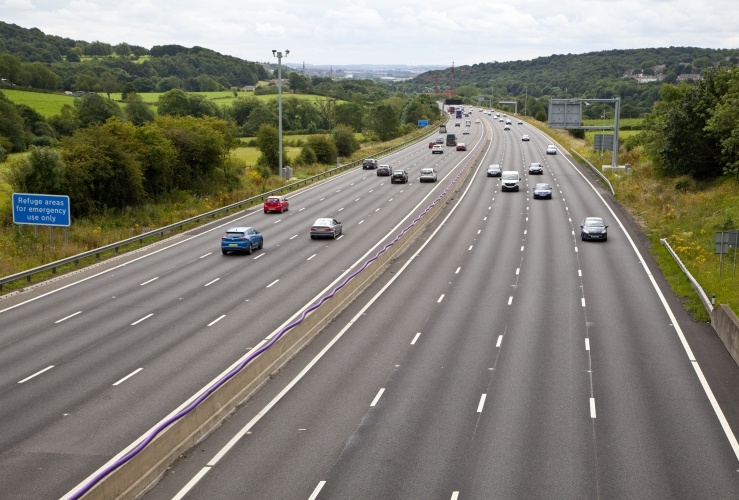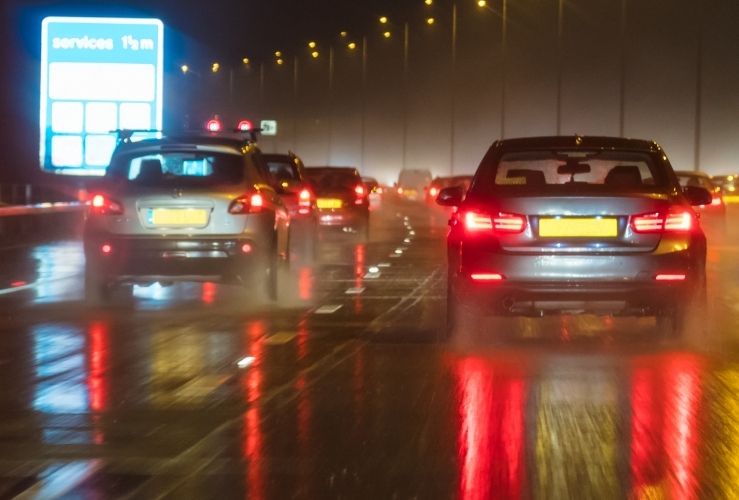Are motorways the safest roads?
It’s often asked are motorways safe and are motorways safer than safer than A roads.
Motorways are in fact the UK's safest roads, accounting for three per cent of accidents and four per cent of fatalities.
However, due to the high speeds involved in motorway driving, when something does go wrong it can have serious and even life-threatening consequences.
Driving safely on a motorway
Having an understanding as to how to drive on the motorway safely can help prevent incidents from happening and build your confidence in motorway driving.
Here we cover some helpful tips for driving on a motorway.

Motorway driving as part of driving lessons
In England, Wales and Scotland learner drivers are allowed on the motorway, so long as they are accompanied by a qualified instructor in a dual-control car displaying red L plates (D plates in Wales).
Driving on a motorway with an Approved Driving Instructor (ADI) can provide you with some invaluable motorway tips.
Motorway driving as a newly passed driver
Not all learner drivers are instructed by an approved driving instructor, and as driving tests do not require motorway experience it is possible that you could start driving having never gained any motorway driving experience.
Even if you do gain experience of driving on a motorway during your driving lessons, newly-passed drivers can find motorway driving daunting, especially in the early weeks and months of motoring.
Read on to learn about safe motorway driving with our motorway driving tips.
Which vehicles are prohibited from using UK motorways?
Which vehicles are prohibited from using the motorway?
Vehicles prohibited from motorways in the UK include
- Holders of provisional motorcycle licences,
- Riders of motorcycles under 50 cc (4 kW),
- Cyclists
- Certain slow-moving vehicles
- Those carrying oversized loads (except by special permission)
- Agricultural vehicles
- Powered wheelchairs/powered mobility scooters (see Rules 36 to 46 inclusive).
As explained in the previous section, provisional car licence holders must not drive on the UK motorway system unless they are accompanied by a DVSA Approved Driving Instructor (ADI) and are driving a car displaying red L plates (or D plates in Wales) with dual controls.
Entering the motorway: How to enter a motorway safely
When it comes to motorway driving in the UK, ensuring you merge onto a motorway in an appropriate way is key to motorway safety.
Indicate
As you move from the slip road towards the motorway itself, use your right indicator to make it clear to other road users that you intend to merge with motorway traffic.
Enter the motorway at an appropriate speed
Try to match your speed with that of the left-hand lane traffic, then identify a suitable gap before merging.
It's very important that you do not slow down dramatically or come to a halt as you approach the end of the slip road. Such behaviour can be dangerous - not to mention frustrating for other road users.
Exiting the motorway: How to exit a motorway safely
It’s equally important to practice good driving skills when preparing to exit the motorway.
Be sure you are in the left lane in good time before you depart from the motorway.
Indicate
There are 100-yard markers leading up to every exit; you should switch on your left indicator by the 300-yard marker - if not before.
Leave the motorway at an appropriate speed
Try not to decelerate while still on the motorway; reduce your speed on the slip road instead. This is safer and will not cause other motorway road users to slow down unnecessarily.
Watch your speed as you enter the slip road.
If you have been cruising at 70mph for a long period, you may not realise how fast you are going once you reach slower roads off the motorway.
Use the correct lane on the slip road
Some slip roads may have two or more lanes. Be sure you are in the correct lane for your intended destination.
How to drive safely on the motorway
Motorway lane discipline: How should you use the lanes on a motorway?
When driving on the motorway, the left hand lane is for travelling in.
The middle and right hand lanes of a motorway are for overtaking only.
Avoid lane hogging
You should not stay in the middle or right-hand lanes of a motorway any longer than necessary.
Lane hogging is an offence
Hogging the middle lane is now an offence and can be extremely unsafe - not to mention annoying for other road users.
When is it appropriate to remain in the middle lane of a motorway?
In rare cases it may be safer to stay in the middle or right-hand lane of the motorway. For example, you may need to overtake a number of slow-moving vehicles, in which case it might not make sense to move into the left lane then back out to the middle lane on numerous occasions.
Pass the slow-moving vehicles, then move back into the left lane of the motorway when it is safe to do so.
A re-cap of the three motorway lanes:
- Lane one (left-hand lane) – travelling
- Lane two (middle lane) - overtaking
- Lane three (right-hand lane) - overtaking
Which vehicles are prohibited from using the right-hand lane on a motorway?
When it comes to motorway driving in the UK, the following vehicles are prohibited from using the right hand lane of the motorway:
- Speed-limited freight vehicles of 3.5 to5 tonnes
- Vehicles over 7.5 tonnes
- Vehicles with trailers
- Speed-limited vehicles designed for more than eight passengers

Driving on the motorway at night
Some drivers feel night time motorway driving is easier, largely because there is a lot less traffic than during daylight hours. However, the Department for Transport states that while only 15% of driving miles are clocked up at night, nearly a third of road injuries and deaths occur in this period.
As such, night time motorway driving deserves special attention.
The coloured studs: Motorway reflective studs
Various coloured motorway reflective studs mark out the road ahead.
Use these coloured studs to understand your position on the motorway at all times.
Motorway reflective stud colours and their meaning:
There are four colours used for motorway reflective studs. These are:
- Red - Hard shoulder division
- Amber - Central reservation division
- White - Mid-lane division
- Green - Slip road division
What is the UK motorway speed limit?
The top - and default - speed on a UK motorway is 70mph.
Smart motorways
Speed limits - and recommended speeds - may change on some motorways.
These figures are displayed on overhead motorway speed signs.
Such motorways are sometimes called 'smart motorways'.
There are two types of ‘smart motorway’ sign:
- Speed shown with a red ring: this is a mandatory speed limit
- Speed surrounded by flashing amber lights: this is an advisory speed, reflecting weather conditions and/or traffic.
For more information about smart motorways, read our blog Smart Motorways: How to use them safely.
The motorway hard shoulder
The hard shoulder was designed for emergency service access and as a place for broken down vehicles to park up safely out of the flow of traffic.
When are you allowed to stop on a motorway?
You should not use the hard shoulder on the motorway unless:
- You have broken down,
- The motorway's Active traffic Management System permits it (i.e. it is indicated on overhead gantries),
- Police/Highways Agency personnel tell you to do so.
Breaking down on a motorway can be an anxious experience. For peace of mind that help will be on hand in the event of a breakdown, ensure you have suitable breakdown recovery cover in place.
Broken down at a motorway service station? Is it fair to get an overstay penalty if you break down at the motorway services?
Dynamic Hard Shoulder Motorways
On some motorways, when traffic volumes are high, traffic may be permitted to use the hard should as a normal lane. These are know as Dynamic Hard Shoulder (DHS) roads.
Where are the Dynamic Hard Shoulder Motorways in the UK?
Sections of DHS can be found on the M1, M4, M5, M6, M42 and M62.
In total, there are around 63 miles of dynamic hard shoulder motorway with variable speed limits, a hard shoulder that can be opened up to traffic at busy times and overhead signs.
When can you not use the hard shoulder on a Dynamic Hard Shoulder Motorway?
The hard shoulder must not be used if the signs over it are blank or display a red X, except in the case of an emergency.
Speeding penalties
Exceeding the stated speed limit on a motorway could land you with a hefty fine - at least 150% of your weekly salary.
Speed cameras are fitted in overhead gantries, so the chances of being caught speeding on a UK motorway are high.
Additional motorway driving tips
These additional motorway driving tips will help to keep you safe when driving on a motorway.
Keep your distance
Keeping your distance from the vehicle in front is key when it comes to knowing how to drive safely on the road.
In normal conditions, leave at least two seconds between you and the vehicle ahead so you have time to stop should the need arise.
In wet or icy conditions, this period should be extended. Aiming for a four second gap is sensible.
Plan your route.
Know the name of the motorway junction you intend to exit through and its location.
Take a break
Take a break at one of the motorway services if you feel tired.
Our helpful blog will help you to understand all you need to know about motorway services car park rules.
Carry out vehicle checks before starting your journey
Ensure your tyres are pumped to the manufacturer's recommended pressure and that your vehicle has sufficient oil and fuel.
Beware of left-hand drive lorries from overseas
These lorries have right-hand passenger seat blind spots, meaning they can fail to see other road users in lanes they move into.
It's a good idea to stay well behind foreign lorries. This extra distance will also make it easier to overtake such vehicles, because you will be able to see more of the road ahead.
Ask someone to accompany you
If you have recently passed your test and do not feel confident using the motorway, ask an experienced driver to accompany you. You might also consider taking some additional driving lessons to sharpen your motorway driving skills.
Take a Pass Plus course
Taking a Pass Plus course may also prove invaluable in making your motorway driving safer and less stressful.
What is Pass Plus?
Pass Plus is a practical training course that takes at least 6 hours and is for drivers to improve their skills and covers driving:
- In town
- In all weathers
- On rural roads
- At night
- On dual carriageways
- On motorways
Driving on a Bank Holiday
For many of us, we find ourselves undertaking motorway driving on a Bank Holiday, when we venture out to visit family or friends or to take the kids on a day trip.
If you will be driving on a Bank Holiday, we have some handy tips for driving on Bank Holidays.
More driving tips from Start Rescue
For more driving tips why not take a look at our checklist of things to look into before you set off on a long journey.
Make sure you've also checked your car load limit else you could face a fine of £300 and three penalty points on your licence.
We also have some helpful advice on how to improve your MPG on long drives (and on how to keep the kids occupied during the journey!).




